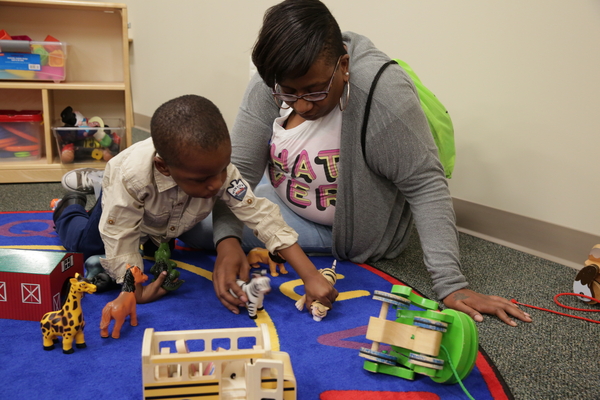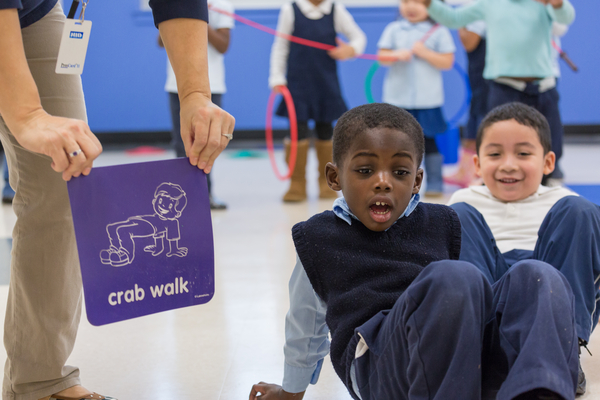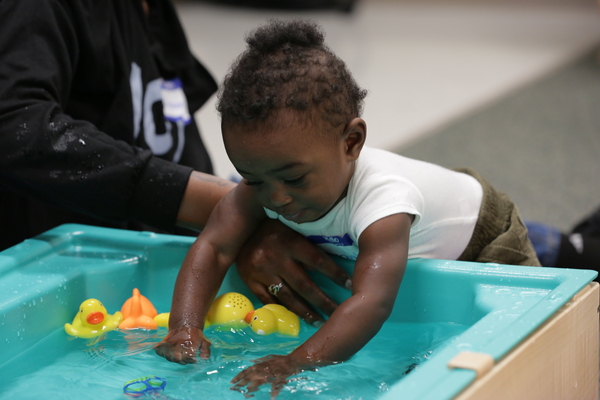 Play-based, active learning environments are key to positive learning experiences. Children develop social, cognitive, language, and physical skills when education staff (e.g., teachers, home visitors, family child care providers) structure learning environments for open-ended, hands-on, active engagement. When families, education staff, and other program staff support active learning, they are affirming the fundamental strengths of young African American boys.
Play-based, active learning environments are key to positive learning experiences. Children develop social, cognitive, language, and physical skills when education staff (e.g., teachers, home visitors, family child care providers) structure learning environments for open-ended, hands-on, active engagement. When families, education staff, and other program staff support active learning, they are affirming the fundamental strengths of young African American boys.
Why Creating a Play-based, Active Learning Environment Matters
Spatial capabilities, or the ability to understand and remember visual and three-dimensional relationships among objects and space, are more pronounced in young male brain development. For this reason, boys, more than girls, tend to be drawn toward active play that requires space for large muscle movement.
The educator and writer Brian Wright describes the concept of verve, which captures the home environment of many African American children. Verve is characterized by:
- Lively and intensified behavior
- Preference for variety and change in an environment
- Preference for multiple activities and stimulation that exist at the same time in the environment
Research shows that verve is an asset of many African American boys and is valued in the home environment. Encouraging verve in group care learning environments and group socializations, which can look like active, lively play, is a culturally sustaining practice.
Giving opportunities for active engagement and learning through play that matches boys’ learning styles can reduce educators’ beliefs they are misbehaving. In these learning environments, girls too can feel empowered to become more active, independent, and creative.
Children benefit from multiple and varied experiences to observe, interact with, and interpret open-ended learning opportunities. They learn with hands-on multisensory materials and social interactions with peers. They need time to play, create, and make decisions. Research says these features of the learning environment are critical for young boys.
Because children of color are sometimes perceived as “behind” in knowledge and skills needed for school, time to play and be active is often limited, and replaced by more teacher-directed activities.
Reflect
 Children show and tell us what they can do and what they need. If an African American boy is constantly moving and physically challenging himself in new ways, how can you use this strength to support his continued development?
Children show and tell us what they can do and what they need. If an African American boy is constantly moving and physically challenging himself in new ways, how can you use this strength to support his continued development?
- In our attempt to keep children safe and help them learn, we often spend a huge part of our days stopping children from moving. In group care settings, is this true for you? Do you find yourself saying things like, “Be careful? No running. Put your bottom on the chair. That’s too dangerous?"
- Pay attention to which children you redirect most often. Are some children warned more often than others? If so, what can you change in the environment? What can you change about how you respond? How can you say “yes” in ways that support learning and active exploration?
- Do you associate a child’s need to be active with challenging behavior?
Visually scan your classroom, family child care, or group socialization setting. Consider the room arrangement, materials, activities, daily schedule, and routines with the following in mind:
- How is active learning and play supported for African American boys? How much time in the day or social activity are they expected to be quiet, sit, or listen to an adult vs. be active, explore, and talk with peers?
- What are ways to expand/extend the times for more active learning?
- What can you do to change the environment, so it supports active learning and play for African American boys?
- If you are a home visitor, ask families about how their child plays at home. What works well? Where are they feeling challenged? Collaborate to find ways to adjust routines and schedules, if needed.
Practices to Create a Play-based, Active Learning Environment
 Research shows that creating play-based, active learning environments for African American boys is a culturally relevant practice.
Research shows that creating play-based, active learning environments for African American boys is a culturally relevant practice.
Encourage large motor and whole-body experiences, using the following as examples:
- In spacious indoor areas, add play tunnels, large mats, ceiling swings, and more to encourage large motor physical play in group care settings. Create space for infants and toddlers to roll, crawl, and pull up and space for preschoolers to jump, climb, crawl, and roll.
- Ask families what type of outdoor, large-motor, and whole-body experiences their child enjoys. Also discuss activities the child enjoys in the learning environment you facilitate.
- To extend learning space in center-based or family child care settings, plan outdoor play activities. You can also move indoor activities outside that include lots of opportunities for movement. For example, move large foam blocks to the outside area so children can build tall towers that require climbing on something to get to the tallest blocks. Or bring chalk outside to draw obstacle courses.
- Include open-ended materials that can be carried and used in multiple spaces in the setting as well as in various learning experiences to support fine and gross motor skill development. For example, clay encourages both fine motor skills, like pinching and poking and large motor skills, like using arm muscles for kneading and pounding.
- Typical exploratory toddler play can be loud and boisterous. Allow space for banging blocks together and running in circles. Bring the activity outside when appropriate.
- Talk with families about how they engage their child in large motor and whole-body experiences. Home visitors can discuss ideas for using items in the home to extend the play (e.g., using a laundry basket and balled-up socks to play indoor soccer).
Materials that encourage inquiry and exploration are ideal. Examples include water and sand tables with containers, experimenting and tinkering centers, or open-ended art materials.
Talk with families about how they can engage with their child in open-ended play. Discuss the value of exploring alternative ways to play with games and toys in the home. For example, a deck of cards can be used to build towers, as a matching or sorting game, or as a blanket that covers sleeping toy cars.
Do not discourage boys from taking part in gendered dramatic play experiences. Introduce play materials that challenge stereotypes such as “boys don’t cry” or “African American boys are only athletes.” Introduce dramatic play themes like kayaking, hiking, theater, barbershop, tech, kitchen, and more to show the range of African American identity.
Create a fidget toy basket for children to assist their focus during large group experiences such as circle time.
See It in Action
These short videos show examples of education staff creating and fostering play-based, active learning environments for young children. As you watch the videos, try to identify the practices education staff use. Did they use indoor areas for large motor play? Were the playing materials open-ended? What practices do you already use? Think about practices to implement in your learning environment. After watching, you’ll have an opportunity to plan for, try out, and reflect on the strategy of creating a play-based, active learning environment.
Loading...
Sandbox
Sandbox
View the transcript
Active Play: Sandbox
Child: Bat.
Teacher: You building that sand house?
Child 2: For a bat.
Teacher: What?
Child 2: A bat.
Teacher: A back? What is a back?
Child 2: A bat.
Teacher: Okay, let's do filling and build. Let's fill our bucket and empty it.
Child: Up there.
Teacher: Okay, let's fill our bucket. What is this building a castle?
Child: Yes.
Teacher: Okay. Oh, look what I can do — I can sift my sand. See?
Child 2: There. What's this?
Woman: [Singing indistinctly]
Teacher: Oh, what? Let's try it again. Let's try it again.
Child 2: What's this?
Child: What's this?
Teacher: Right. What is that? What color is that one?
Child 2: White.
Teacher: White? Okay.
Child 2: Look what I made.
Teacher: Okay. You made it so good.
Close
Educators can ask questions and model play to support active participation. In this video, an educator facilitates play in an outdoor sandbox of a family child care setting. How is this educator supporting active participation in play?
Try It!
Download the Try It! worksheet and choose one practice to focus on for one month. Use the prompts in the worksheet to thoughtfully plan how you will use the practice. The worksheet includes prompts for reflection after using the practice for one month.
Deepen Your Learning
 These resources provide more information on active play and creating rich learning environments:
These resources provide more information on active play and creating rich learning environments:
Connections to Head Start Standards, Frameworks, and Principles
In this section, learn about Head Start practices that support the school readiness and success of young African American boys. Think about your program and your learning setting and consider ways you already do these practices and ways you can more closely align to improve your teaching practice.
Head Start Program Performance Standards
Head Start Early Learning Outcomes Framework
Encouragement of play can be found throughout the ELOF domains and subdomains:
- Approaches to Learning — Creativity
- Social and Emotional Development — Relationships with Other Children
- Language and Literacy — Communicating and Speaking
- Cognition — Imitation and Symbolic Representation and Play
- Perceptual, Motor, and Physical Development — Perception, Gross Motor, and Fine Motor
Check out the ELOF Effective Practice Guides for more information about domain-specific teaching practices that support development and learning from birth to age 5.
Multicultural Principles for Early Childhood Leaders
Implementation of the multicultural principles honors the cultural diversity of children, families, and communities served in Head Start programs.
Last Updated: February 21, 2024
 These resources provide more information on active play and creating rich learning environments:
These resources provide more information on active play and creating rich learning environments: Play-based, active learning environments are key to positive learning experiences. Children develop social, cognitive, language, and physical skills when education staff (e.g., teachers, home visitors, family child care providers) structure learning environments for open-ended, hands-on, active engagement. When families, education staff, and other program staff support active learning, they are affirming the fundamental strengths of young African American boys.
Play-based, active learning environments are key to positive learning experiences. Children develop social, cognitive, language, and physical skills when education staff (e.g., teachers, home visitors, family child care providers) structure learning environments for open-ended, hands-on, active engagement. When families, education staff, and other program staff support active learning, they are affirming the fundamental strengths of young African American boys. Children show and tell us what they can do and what they need. If an African American boy is constantly moving and physically challenging himself in new ways, how can you use this strength to support his continued development?
Children show and tell us what they can do and what they need. If an African American boy is constantly moving and physically challenging himself in new ways, how can you use this strength to support his continued development? Research shows that creating play-based, active learning environments for African American boys is a culturally relevant practice.
Research shows that creating play-based, active learning environments for African American boys is a culturally relevant practice.